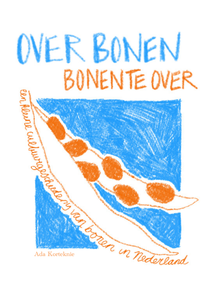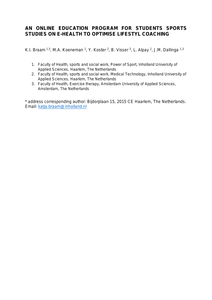Developing Genetic Markers for Capsicum disease
DOCUMENT
Global climate change (CC) affects marine mammals, such as cetaceans, by exposing them to an altered marine environment. Cetaceans are indirectly influenced by CC (e.g. through their prey, warmer environment). They are indicator species, significant to marine ecosystems and one of the most endangered vertebrate groups on this planet. Since oceanic water temperatures have increased, a noticeable shift in diversity of cetaceans present in marine hotspots is expected. In this paper, the community structure (occurrence) of cetacean species present around São Miguel Island, Portugal were investigated to contribute to the current understanding of the effects of CC on cetaceans.
DOCUMENT

Background Anxiety and challenging behaviour (CB) often occur simultaneously in people with intellectual disabilities (ID). Understanding the associations between anxiety and CB may contribute to more accurate diagnoses and management of both anxiety and CB in this population. Aims To examine the relationship between anxiety and CB. Methods A literature review covering the period from January 2000 to January 2012. Results Seven studies about the relationship between psychiatric disorders, including anxiety, and CB were identified. These studies confirm the relationship between anxiety and CB in people with ID, although the precise nature of this relationship remains unclear. Conclusions The study points toward the existence of a moderate association between anxiety and CB. Further research is needed to clarify the complex nature of the association between anxiety and CB.
DOCUMENT

DOCUMENT

The sensitivity of tropical forest carbon to climate is a key uncertainty in predicting global climate change. Although short-term drying and warming are known to affect forests, it is unknown if such effects translate into long-term responses. Here, we analyze 590 permanent plots measured across the tropics to derive the equilibrium climate controls on forest carbon. Maximum temperature is the most important predictor of aboveground biomass (−9.1 megagrams of carbon per hectare per degree Celsius), primarily by reducing woody productivity, and has a greater impact per °C in the hottest forests (>32.2°C). Our results nevertheless reveal greater thermal resilience than observations of short-term variation imply. To realize the long-term climate adaptation potential of tropical forests requires both protecting them and stabilizing Earth’s climate.
DOCUMENT

Publicatie bij de rede, uitgesproken bij de aanvaarding van het ambt als lector Green Biotechnology aan Hogeschool Inholland te Amsterdam op 20 mei2015 door dr. C.M. Kreike
DOCUMENT

Dit boekje is een kleine cultuurgeschiedenis over bonen in Nederland. Het is steeds bekender dat bonen belangrijk zijn binnen de eiwittransitie, maar toch eten Nederlanders amper bonen in vergelijking met andere delen op de wereld. Dat, terwijl bonen heel goed en goedkoop geteeld kunnen worden in Nederland, vezel- én eiwitrijk zijn en daarmee een goed alternatief vormen op dierlijke eiwitten. Nog niet zo lang geleden aten mensen in Nederland veel meer bonen dan nu, maar gedurende de afgelopen eeuw zijn ze steeds meer van ons bord en uit ons landschap verdwenen. Ook het onderzoek van Aeres en het lectoraat Stedelijke Voedselvraagstukken laat zien dat veel mensen niet echt meer raad weten met de boon. Dit boekje is een verkenning naar welke rol bonen hebben gespeeld in het verleden en wat hun herwaardering kan betekenen, met als doel te laten zien dat bonen oude bekenden van ons zijn.
DOCUMENT

In dit abstract wordt de ontwikkeling van een online onderwijsmodule beschreven gericht op eHealth voor leefstijlverbetering
MULTIFILE

Background Physical activity after bariatric surgery is associated with sustained weight loss and improved quality of life. Some bariatric patients engage insufficiently in physical activity. The aim of this study was to examine whether and to what extent both physical activity and exercise cognitions have changed at one and two years post-surgery, and whether exercise cognitions predict physical activity. Methods Forty-two bariatric patients (38 women, 4 men; mean age 38 ± 8 years, mean body mass index prior to surgery 47 ± 6 kg/m²), filled out self-report instruments to examine physical activity and exercise cognitions pre- and post surgery. Results Moderate to large healthy changes in physical activity and exercise cognitions were observed after surgery. Perceiving less exercise benefits and having less confidence in exercising before surgery predicted less physical activity two years after surgery. High fear of injury one year after surgery predicted less physical activity two years after surgery. Conclusion After bariatric surgery, favorable changes in physical activity and exercise cognitions are observed. Our results suggest that targeting exercise cognitions before and after surgery might be relevant to improve physical activity.
MULTIFILE
Development of novel testing strategies to detect adverse human health effects is of interest to replace in vivo-based drug and chemical safety testing. The aim of the present study was to investigate whether physiologically based kinetic (PBK) modeling-facilitated conversion of in vitro toxicity data is an adequate approach to predict in vivo cardiotoxicity in humans. To enable evaluation of predictions made, methadone was selected as the model compound, being a compound for which data on both kinetics and cardiotoxicity in humans are available. A PBK model for methadone in humans was developed and evaluated against available kinetic data presenting an adequate match. Use of the developed PBK model to convert concentration–response curves for the effect of methadone on human-induced pluripotent stem cell-derived cardiomyocytes (hiPSC-CM) in the so-called multi electrode array (MEA) assay resulted in predictions for in vivo dose–response curves for methadone-induced cardiotoxicity that matched the available in vivo data. The results also revealed differences in protein plasma binding of methadone to be a potential factor underlying variation between individuals with respect to sensitivity towards the cardiotoxic effects of methadone. The present study provides a proof-of-principle of using PBK modeling-based reverse dosimetry of in vitro data for the prediction of cardiotoxicity in humans, providing a novel testing strategy in cardiac safety studies.
DOCUMENT
